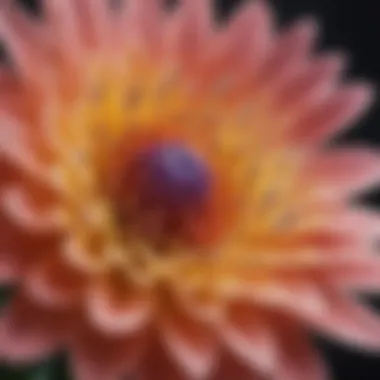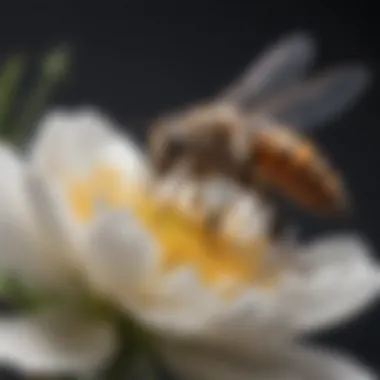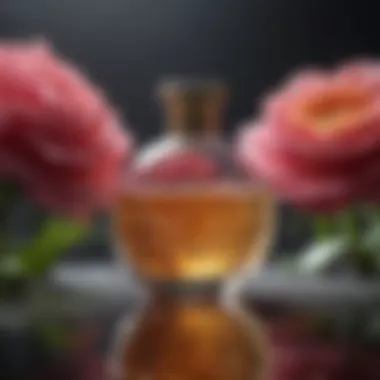The Intricacies of Smelling Flowers: Aromatic Insights


Intro
The rich and diverse world of floral aromas encapsulates much more than mere beauty. Floral scents are a crucial mode of communication among plants, pollinators, and humans alike. This article investigates the underlying biochemical processes that give rise to floral fragrances, as well as their ecological roles and cultural ramifications. Understanding these aromas is vital in recognizing how various species interact with their surroundings. The interplay between fragrance and perception, particularly from the perspective of pollinators and humans, invites a deeper look into a seemingly simple yet profoundly complex phenomenon.
Fascinating Facts About Flowers
Unique Characteristics
Flowers possess distinctive characteristics that go beyond their vibrant colors. Each flower species emits specific scents, which can greatly differ in composition and intensity. For instance, roses release a sweet fragrance attributed to compounds like geraniol and citronellol. Conversely, the odor from Rafflesia arnoldii, known as the corpse flower, is foul, resembling decaying flesh. This scent attracts specific pollinators, such as carrion flies, demonstrating how floral aromas evolve uniquely to ensure reproductive success.
Extraordinary Abilities
Flowers have impressive abilities when it comes to using their scents strategically. They can alter their fragrance profiles at different times of the day to attract various pollinators. For example, some evening-blooming plants release stronger scents at night to lure nocturnal pollinators like moths. This adaptability showcases a sophisticated understanding of ecological interactions, illustrating how plants can modify their attractants based on environmental cues.
Understanding Floral Fragrance
Floral fragrance plays a significant role in the interaction between flowers and their environment. This section aims to unpack the multifaceted elements of floral scent, offering insights into its chemical composition, evolutionary significance, and ecological impacts. Understanding floral fragrance allows us to appreciate not only the beauty of flowers but also their critical functions in ecosystems.
Floral scents are more than just pleasant aromas. They are key signals in the natural world, impacting both pollinators and humans. The exploration of floral fragrances leads us to various components, primarily volatile organic compounds, which are integral to the chemistry of scents. Knowing how flowers produce these scents helps us appreciate their evolutionary strategies and biological significance.
The Chemistry of Flower Scents
Volatile Organic Compounds
Volatile Organic Compounds (VOCs) are crucial in the dialogue between flowers and their pollinators. VOCs are organic molecules that easily evaporate at room temperature, allowing them to disperse into the atmosphere. One key characteristic of VOCs is their role in attracting specific pollinators. Flowers leverage these compounds to send out signals that guide pollinators to them. This feature makes VOCs a beneficial choice in our exploration of floral aromas.
The unique feature of VOCs lies in their diversity. Different flowers emit varying profiles of these compounds, each tailored to attract particular pollinators. For instance, some may produce sweet-smelling esters, while others may emit herbal or spicy notes. The advantage of VOCs is their ability to adapt to environmental factors, such as temperature, which can enhance or diminish scent production.
Terpenes and Their Variability
Terpenes are a significant subset of VOCs found in flowers. These aromatic compounds contribute greatly to the scent profile of many plants. A key characteristic of terpenes is their structural variability, which leads to a rich diversity of aromas. This variability is beneficial for distinguishing between species and attracting different types of pollinators.
The unique feature of terpenes is their biological function. They not only attract pollinators but also serve as defenses against herbivores. This dual role supports the overall ecology of the plant. However, terpenes can have drawbacks, as their production may require significant energy from the plant, particularly in adverse environmental conditions.
Aroma Profiles Across Species
Aroma profiles across species illustrate the specificity of floral scents in the natural world. Each species of flower produces a distinct combination of scents that helps in pollinator recognition and preference. A key characteristic of these aroma profiles is their complexity, often resulting from the interaction of multiple compounds. This makes the study of aroma profiles a popular and important topic in botany.
The unique feature of these profiles is their evolutionary adaptation. Different environmental conditions and pollinator preferences have shaped the scent compositions of various flowers. The advantage here is that specific scents can lead to more effective pollination strategies, enhancing reproductive success. Yet, with climate change, these profiles may vary, and adaptations will have to balance ancient traits with new environmental demands.
Evolution of Floral Scent
Pollination Strategies
Pollination strategies are fundamental to understanding why floral scents evolve as they do. Flowers adapt their scents to optimize pollination. A key characteristic of these strategies is their dependence on specific pollinator behaviors. For example, some flowers emit strong scents to attract nocturnal pollinators, like moths, while others may rely on subtle scents to allure daytime bees.
The unique feature of pollination strategies is the interplay between scent and flowering time. This synchronization ensures that floral scents align with pollinator activity. While this strategy enhances reproductive success, it also limits the scope of flowering species in different habitats. As conditions change, this interdependence will be crucial to study further.


Attracting Pollinators
Attracting pollinators involves various techniques, prominently the effective use of scent. The production of distinct aromas is essential for flowers to lure their target pollinators. A key characteristic of this process is the balance between quantity and quality of scent released. An effective floral scent can create a significant draw for species like bees and butterflies.
The unique feature lies in the evolutionary benefits. Flowers that successfully attract pollinators are more likely to reproduce. However, relying heavily on scent can also create competition among species, leading to an evolutionary arms race where flowers must constantly adapt their fragrances to maintain their allure.
Adaptations to Environmental Changes
Adaptations to environmental changes significantly affect floral scent production. As climate patterns shift, flowers may be forced to adjust their scent profiles to remain effective in attracting pollinators. A key characteristic of these adaptations is their responsive nature to ecological pressures.
The unique feature of such adaptations is that they can lead to rapid evolutionary changes within specific populations. This flexibility is crucial for survival, but it may also have limits. Continuous environmental stress may hinder some species' ability to adapt, potentially jeopardizing their long-term survival.
The Role of Smelling Flowers in Ecosystems
The role that floral aromas play in ecosystems is multifaceted. Flowers do not merely add beauty to our surroundings; they are vital components in the intricate web of life. Their scents facilitate essential relationships between plants and animals. Understanding these interactions is crucial for comprehending broader ecological dynamics.
Pollinators and Their Preferences
Bees and Their Responses
Bees exhibit a remarkable responsiveness to floral scents, which directly impacts their foraging behavior. They can detect certain volatile compounds emitted by flowers. This skill allows them to locate nectar-rich flowers more effectively. The key characteristic of bees' responses is their ability to discern subtle differences in scent profiles. This is not just beneficial; it is essential for their survival as they rely heavily on floral resources.
A unique aspect of bees' scent attraction is their preference for specific floral volatiles. They tend to favor flowers that emit pleasant and strong scents. This trait influences their selection of plants and supports biodiversity. However, an over-reliance on scent can also lead bees to overlook less prominent flowers, which may result in an imbalance in pollination.
Butterflies and Scent Attraction
Butterfly attraction to scents offers another dimension to understanding floral preferences. Unlike bees, butterflies have a less acute sense of smell, but they are still responsive to floral aromas. They often choose flowers based on vibrant colors paired with appealing scents. This characteristic makes butterflies important for pollination in many ecosystems.
The unique feature of butterflies' scent attraction is their feeding strategy. They are more likely to visit flowers with a combination of strong visual appeal and fragrance. This can create opportunities for mutual benefits between flowers and butterflies. However, their dependence on specific floral scents can sometimes limit their foraging options, especially in altered environments.
Birds and Fragrance-driven Foraging
Birds, particularly nectar-feeders, are less studied in terms of scent attraction. However, they are impacted by floral aromas during foraging. Many birds rely on the fragrance of flowers to find food sources. The primary aspect here is that the scent can guide birds in seeking out flowers with abundant nectar, enriching their foraging experience.
One notable characteristic of birds in relation to floral scents is their distinct response to different aromas. Some birds show preferences based on specific scent profiles. This connection highlights the significance of aromatic signals in avian pollination behavior. Yet, their focus on scent can be influenced by other factors like color and plant density, which may create complexities in their foraging decisions.
Plant-Pollinator Interdependence
Mutual Benefits Explained
The relationship between plants and pollinators generally reveals mutual benefits for both parties. While plants gain necessary pollination services, pollinators receive food resources. Highlighting this interdependence illustrates the key role of floral scents in facilitating these interactions. It is not only advantageous; it is essential for maintaining ecological balance.
The unique feature of mutual benefits lies in plant adaptations to attract specific pollinators through scent. They evolve compounds that appeal most to their effective pollinators. However, reliance on certain pollinators creates vulnerabilities. If a key pollinator faces decline, the plant species may suffer.
The Balance of Adaptation
Adaptation plays a vital role in the relationship between plants and pollinators. Each species evolves based on its interactions with one another. The balance of adaptation ensures that floral scents continue to align with the sensory capabilities of their respective pollinators. This is a popular point of discussion in ecology, illustrating how these relationships can support biodiversity.


As plants adapt to attract pollinators, they may also face challenges. Changes in the environment can disrupt established relationships. If pollinators cannot find scents they are accustomed to, this could compromise their role in pollen transfer, affecting the ecosystem.
Consequences of Pollinator Decline
The decline of pollinators poses significant consequences for ecosystems. As various species face threats, such as habitat loss and pesticides, their ability to locate and utilize floral scents diminishes. This loss of pollinators not only impacts flowers but also alters the dynamics of entire ecosystems.
Understanding the implications of this decline helps highlight the importance of floral scents in supporting life. The key characteristic here is the potential for cascading effects on food webs and plant populations. As fewer pollinators interact with flowers, less genetic diversity may result. This could eventually lead to extinctions and a decrease in ecosystem health.
Maintaining healthy pollinator populations is critical for ensuring that floral scents can continue to serve their essential ecological functions.
Human Interaction with Floral Aromas
Human interaction with floral aromas is an essential aspect of understanding how we relate to the natural world. Flowers not only serve ecological purposes but also carry cultural and psychological significance. Their scents influence human emotions, inspire creativity, and enrich traditions across various cultures. In examining human interactions with floral fragrances, we see how they shape our experiences and enhance our lives. This section reveals the multifaceted relationship between people and floral aromas.
Cultural Significance of Flowers
Flowers in Art and Literature
Flowers have been a central theme in art and literature for centuries. Their vibrant colors and captivating aromas inspire creative expression. Artists and writers use flowers to convey deeper meanings and emotions. For instance, Van Gogh's
Practical Applications of Floral Fragrance
Floral fragrances have practical applications that extend beyond the aesthetic or emotional pleasure they provide. From enhancing wellbeing to influencing consumer behaviors, the significance of these scents is multifaceted. Understanding these applications aids in the appreciation of flowers beyond their visual beauty.
Essential Oils and Aromatherapy
Extraction Methods of Essential Oils
Extraction methods of essential oils play a crucial role in the quality and characteristics of the final product. Common methods include steam distillation, cold pressing, and solvent extraction. Each method affects the properties of the essential oil extracted.
Steam distillation is the most widely used method due to its effectiveness. It preserves the delicate aromatic compounds found in flowers, providing a high-quality essential oil. Cold pressing is typically used for citrus fruits but can be beneficial for certain flowers as well. Solvent extraction, while effective in yielding a larger quantity of oil, can leave chemical residues that may alter the fragrance.
Each extraction method has advantages and disadvantages. For instance, steam distillation is recognized for maintaining stability and purity of the oils, but it may not yield as much oil compared to solvent extraction. Thus, the choice of method can significantly influence the therapeutic properties of floral scents, essential for aromatherapy applications.
Therapeutic Uses of Floral Scents
Therapeutic uses of floral scents are gaining traction within wellness practices. Floral aromas can evoke emotional responses and aid in relaxation, which is critical in therapeutic settings. Scents like rose and lavender are commonly associated with reducing anxiety and enhancing mood.
The ability to trigger specific emotional and mental health benefits proves valuable. Studies show that certain floral scents can improve focus and memory, making them appealing in educational settings. However, overexposure or allergic reactions can be a potential drawback. Thus, understanding these therapeutic aspects is significant in integrating floral fragrances into holistic health practices.
Benefits vs.
Risks in Aromatherapy
Examining the benefits and risks in aromatherapy is essential for users. Floral scents can provide stress relief, promote relaxation, and enhance emotional wellbeing. Popular oils like jasmine or ylang-ylang are often cited for their uplifting qualities.
However, like any therapeutic approach, risks do exist. Misuse or inappropriate blending of oils can lead to adverse reactions. Additionally, quality control in essential oil production is critical, as subpar products may not yield the anticipated benefits. Evaluating these factors ensures that the practice of aromatherapy remains safe and effective for users.


Fragrance in Consumer Products
Perfume and Scented Products
The integration of floral scents in perfume and scented products is a booming segment of the fragrance industry. High-quality perfumes often rely on an intricate balance of floral notes to create appealing scents. Rose, jasmine, and lavender are popular choices due to their rich aromatic profiles.
These fragrances are not only pleasing but are also strategically chosen to evoke specific feelings. The unique blend of floral ingredients can enhance personal branding and emotional attachment to the product. However, the synthetic alternatives in scented products can sometimes detract from the benefits associated with natural floral scents, raising questions about authenticity and consumer trust.
Marketing and Consumer Behavior
Marketing tactics around floral fragrances significantly influence consumer behavior. Companies often capitalize on the emotional connection that floral scents foster in their advertising strategies. This connection can lead to enhanced brand loyalty and increased sales.
Understanding consumer preference for floral aromas can guide product development. However, the market is also competitive, as consumers become more knowledgeable about ingredients. Transparency about sourcing and formulation becomes critical to maintaining trust and loyalty in a discerning market.
Sustainability Considerations
Sustainability considerations in floral fragrance production are crucial for the long-term viability of the industry. The extraction of floral scents can have environmental impacts, particularly if sustainability practices are not upheld.
Brands must balance consumer demand with environmental responsibility. Outsourcing from areas that prioritize sustainability can improve the reputation of products. However, ensuring that these practices are cost-effective for manufacturers can pose challenges. Awareness and active engagement in sustainable practices are essential in cultivating this aspect of the fragrance industry.
Understanding the practical applications of floral fragrances not only enhances our appreciation of these aromas but also informs ethical and sustainable practices in their use.
Future Directions in Floral Scent Research
Research on floral scents continues to evolve. The future directions in this field are vital due to their potential impact on both ecology and human interaction with flowers. As we explore how floral aromas influence our environment, we also uncover ways to enhance conservation efforts and improve agricultural practices.
Innovations in Scent Technology
Advancements in Scent Synthesis
Advancements in scent synthesis focus on creating artificial versions of natural floral aromas. This is important as it allows for a controlled production of specific fragrances without relying on the actual flowers. A key characteristic of this approach is its sustainability. It reduces pressure on natural habitats that provide these scents. However, there are concerns regarding the complexity of replicating the full depth of natural aromas in synthetic forms. While sometimes cheaper and readily available, these synthesized scents can lack the richness found in their natural counterparts.
Biotechnology and Floral Fragrance Generation
Biotechnology has opened new horizons in generating floral fragrances. Through genetic modification and synthetic biology, scientists can now express floral scent compounds in different organisms. This innovation has great potential to maintain or even increase the diversity of scents found in flowers. The main advantage of this approach is the ability to produce scents at scale and potentially reduce habitat destruction. Nonetheless, ethical issues and public perceptions around genetically modified organisms must be considered.
Potential Applications in Conservation
Research into the potential applications of floral fragrances in conservation efforts is crucial. Using scent for habitat restoration can help attract necessary pollinators back to areas suffering from biodiversity loss. This represents a unique feature of leveraging floral aromas to revitalize ecosystems. One significant advantage is that it provides a dual benefit of enhancing natural habitats while also promoting species resilience. However, difficulties in effectively targeting the right species remain a challenge in applying this research effectively.
Environmental Impacts on Flower Aromas
Climate Change and Scent Variation
The effects of climate change on scent variation in flowers is an emerging area of study. Changes in temperature and precipitation patterns can lead to altered chemical compositions of flower aromas. This aspect is vital for understanding how plants adapt to changing environments. An important characteristic of this topic is its relevance to pollination. If flower scents change, it may disrupt established relationships with pollinators that rely on these signals. Understanding these variations might help in developing strategies to support these plants and their pollinators in a warming world.
The Role of Urbanization
Urbanization significantly impacts flower scents by altering local ecosystems. Urban environments often lead to a loss of plant diversity, which in turn affects the variety of floral fragrances available in these areas. One key aspect of this is the reduced effectiveness of traditional pollination strategies. As urban settings continue to expand, it becomes more critical to study how floral scents evolve in these landscapes. The complexities of managing these changes provide opportunities for future research, though urban environments may limit the scope of natural fragrance diversity.
Conservation Strategies for Floral Diversity
Effective conservation strategies for floral diversity are essential. Preserving a variety of floral scents can enhance ecosystem resilience by maintaining healthy pollinator populations. A notable feature of these strategies is their holistic approach to biodiversity. Engaging in habitat restoration and promoting planting native species can encourage a rich tapestry of aromas. However, balancing human development and conservation efforts remains a delicate challenge that requires ongoing commitment and innovative solutions.







